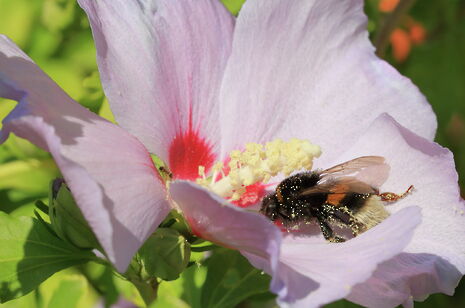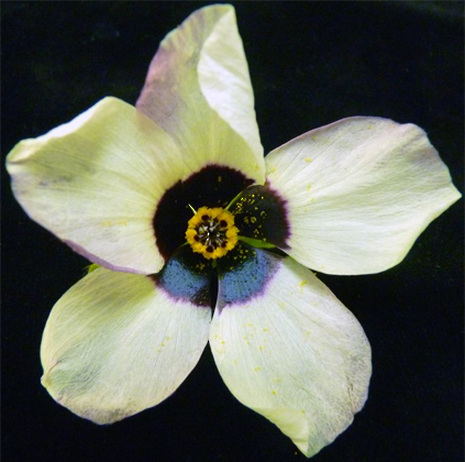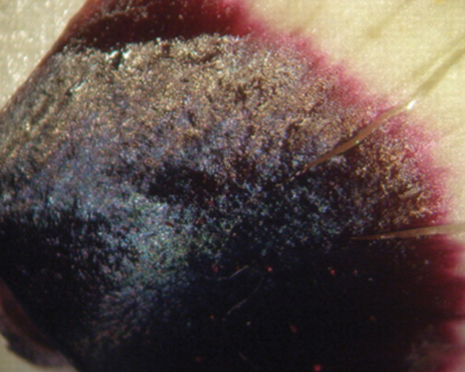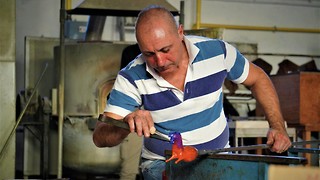All the (blue) light we cannot see
Sofia Weiss in conversation with Beverly Glover, Professor of Plant Sciences and Director of Cambridge Botanical Garden

Flowers at first, may seem like one little more than life’s simple pleasures; however, new research from Cambridge’s own Department of Plant Sciences reveals that there is more to them than meets the eye – the human eye, at least. Professor Beverley Glover’s latest paper, published this month in the journal Nature, details how some common varieties of flower have evolved to display a ‘blue halo’ of shimmering light that lies largely beyond the range of human vision, but proves immensely attractive to bees.
Essentially hidden in plain view, the effect is created by spaghetti-like ridges a few millionths of a centimetre in diameter that appear on various blooms including a peony, a tulip and a kind of hibiscus. In fact, it was stumbling across this latter plant – the Hibiscus trionum, known to gardeners as ‘the flower-of-the-hour’ – in the University’s Botanical Gardens that spurred on Professor Glover’s study into structural colour in the first instance. About ten years ago, she recounts, one of her post-doc students (Heather Whitney) returned to the lab clutching a hibiscus; she had noticed that despite the petals initially appearing white and red, when the flower was twisted shades of blue and green came into view. Additionally, under certain angles the flower appeared to have a peculiar iridescent sheen on top of the more readily-visible red pigment.

“What we wanted to know,” Professor Glover says, “was whether this was a weird one-off, or whether other flowers might play the same trick with light.” Having looked at their flower under the electron microscope, they knew that the cells underneath the surface of the petal – the cuticle – would have to be approximately flat to produce a colour-effect like the one observed; that is, one dependent on the angle. So, they went back into the living collection of the Botanical Gardens, to find more samples of flowers known to have flat surface cells for comparison. What they found would prove to be potentially one of the greatest examples of convergent evolution in botany of our time: at least 11 families of flowers had not only the same iridescent blue halos, but also the same microscopic ridges capable of generating different colours depending on the angle from which the flower was observed (an effect known as diffraction grating).
This is significant for a number of reasons. Firstly, true blue flowers are exceedingly rare, and not for lack of effort. “The chemistry is simply very difficult,” Professor Glover states, adding that “you will never get a naturally blue rose, for example,” because tweaking the pigments to make them bluer necessitates special chemical tricks like adding alcohol groups, or making the pH more alkaline, and most of the time these simply require too much energy, or enzymes that aren’t naturally present in the flower. The majority of flowers instead get their colours from pigments called anthocyanins, which typically look pink or red; when you try to tweak these, the results are essentially purple. But a handful of flowers, like cornflowers and Himalayan blue poppies, have managed to achieve “true blue” and Glover argues that, whilst it might seem like a lot of effort, there is a “selective advantage” to this.

Ubiquitous pollinators such as bees have pigments in their eyes to see wavelengths corresponding from ultraviolet to green. Blue lies right in the middle of these. So, it makes “functional sense” that this colour would be selected as a “salient marker for pollinators”. The benefit to the plant, is that it is hence more likely to have its pollen collected and reproduce as a result, the ultimate goal of any biological being. The physics also explains why humans cannot easily see the halo described: our vision is right-shifted towards slightly higher wavelengths of light, and so will miss out on the scattered blue most of the time.
Secondly, - and incredibly - the microscopic ridges responsible for diffracting the light in the manner observed all exhibit the same degree of disorder, even though they have evolved independently. The maths of the microscopic structure for all the plants studied lies within “the Goldilocks zone,” a range which, as Glover explains, is where the ridges are “disordered, but not too disordered”. The variation may be in the heights, widths or spacing of the peaks and troughs, but so long as the overall pattern contains the same degree of chaos, the blue signal produced is consistent. “It’s a different way of making blue,” Professor Glover says, “one that focuses on structure, and the scattering patterns that this will generate.”
The implications of this photonic signature are likely to be far reaching. For the physicists with which the team worked, biomimicry is the name of the game. In understanding how flowers can naturally generate the colour blue in the unique fashion discovered, the doors are opened for scientists for artificial replication.
The benefits of this, Professor Glover describes, would be that “unlike chemical pigments, structural colour doesn’t fade”. She amusingly cites the example of bleached camcards, which could be replaced with iridescent versions if this natural technology can be harnessed at the research bench. Her own lab, however, are more interested in the mechanics of how the relevant plants are able to modulate their cuticle ridges in order to produce specific colour signals, and hence hypnotise their pollinators. The next steps for her research then, she highlights, are in the developmental biology of the system, and pinning down the genes involved.
The “blue halo” is a hugely exciting finding for the department. Professor Glover stresses though, that it would not have been possible without the Botanic Gardens: “It’s a fantastic resource not only for research, but also for teaching and learning.” Most importantly, she reminds me, it’s free for students – “so you should be going lots!” Given the potential for discovery and delight alike, perhaps we should all follow her suggestion
 Comment / The (Dys)functions of student politics at Cambridge19 January 2026
Comment / The (Dys)functions of student politics at Cambridge19 January 2026 News / Local business in trademark battle with Uni over use of ‘Cambridge’17 January 2026
News / Local business in trademark battle with Uni over use of ‘Cambridge’17 January 2026 Arts / Exploring Cambridge’s modernist architecture20 January 2026
Arts / Exploring Cambridge’s modernist architecture20 January 2026 Features / Exploring Cambridge’s past, present, and future18 January 2026
Features / Exploring Cambridge’s past, present, and future18 January 2026 News / Your Party protesters rally against US action in Venezuela19 January 2026
News / Your Party protesters rally against US action in Venezuela19 January 2026







